CEP – KAS: Sahel Monitoring September 2023

This tenth monthly report monitoring activities of al-Qaeda and Islamic State branches throughout the Sahel will focus on the propaganda output of these groups in September 2023.
An initial observation is that the number of claimed attacks remains at the same level when compared to August. Fifty-seven separate incidents have been registered. But perhaps the most remarkable fact is that ISGS was last mentioned in an-Naba’ 405 and did not claim a single attack even though it is very clear that they continue to be highly active in the Jihadist insurgency in Mali and Niger. This results in the somewhat strange observation that Jama’a Nusrat ul-Islam wa al-Muslimin’ (JNIM) is now more active than both branches of the ISIS throughout the region. Similar to previous months, most attacks reported by the Islamic State in Western Africa Province (ISWAP) are of relatively low impact, with a lower number of casualties per attack. The deadliest attack was reported on September 8 in an-Naba’ issue 407, with a death toll of 15 killed and wounded. Although it is clear that the Islamic State in the Greater Sahel (ISGS) is by far more lethal and impactful in its attacks, their propaganda outlets did not report any terrorist operations at all this month and therefore there is no output that can be analyzed for this report. The strategic silence of ISGS is deafening. It remains to be seen whether or not the group is preparing a larger scale operation or campaign, which would explain its current silence.
Attacks in the Sahel: General Trend
Given the fact that not a single claim was published by ISGS, the steady trend of a rising number of attacks throughout the months has come to a halt. Only 57 incidents were reported by az-Zallaqa Media and an-Naba’. As mentioned, most incidents were claimed by JNIM, totalling 35. The overall majority of these attacks was claimed in Mali, with a total of 20 attacks. Burkina Faso was struck by at least 14 different attacks by JNIM, one resulting in the claimed killing of over 50 Burkinabe soldiers on September 4. For the first time since systematic monitoring started at the end of 2022, Benin was hit by JNIM.
Although ISGS did not claim a single attack in its propaganda outlets, there are strong indications from other sources that the group was involved in several highly impactful attacks throughout Mali and Niger in September.
Mali is rapidly descending into further general chaos. On September 4, JNIM even communicated via az-Zallaqa Media that the group is besieging the entire city of Timbuktu, the largest city in the north of Mali.
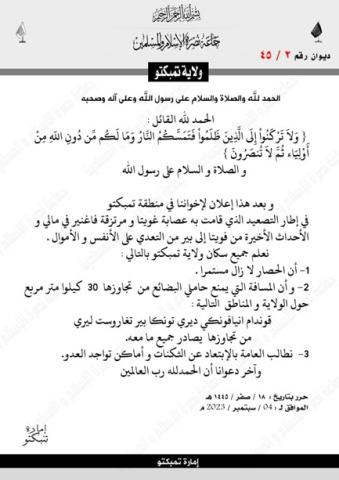
On September 7, 64 civilians were killed by JNIM on a ferry in the area of Mopti. Interestingly, JNIM’s propaganda outlets subsequently denied the group’s involvement.

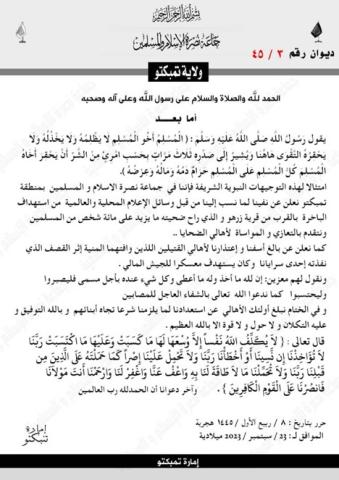
Another worrying event that became clear in late August already is the alleged ceasefire between ISGS and JNIM. In the past few months, ISGS had repeatedely attacked JNIM fighters in an apparent conflict over territory and influence. However, currently, it seems that both groups have reached some kind of agreement and seem to focus on their common enemies: the Malian Army and the Wagner Group. Therefore, a mutual weakening of these two terrorist groups can currently not be expected.
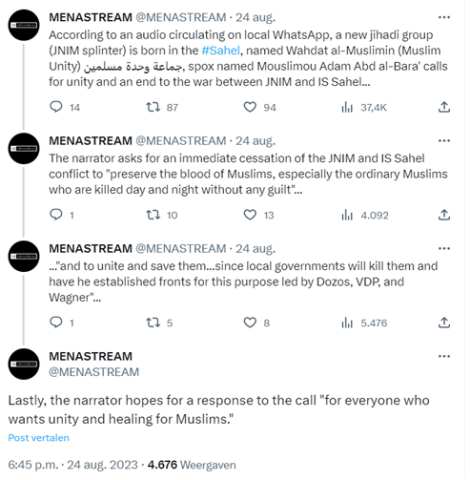
This agreement seems to be a strategic ceasefire, as both JNIM and ISGS are dividing Mali into separate areas of control.
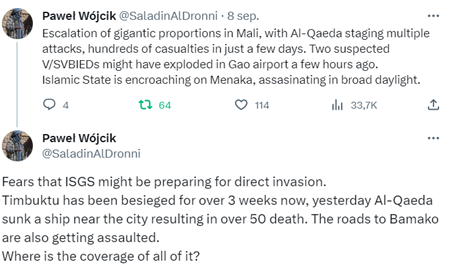
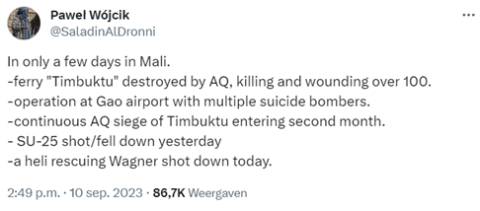
The crash referred to by Pawel in his last tweet above refers to a significant accident in which an overloaded Iliouchine76 TZ98 airplane overestimated the runway and fatally crashed and exploded, killing at least 16 Wagner mercenaries and three Malian soldiers, including an air force Colonel.
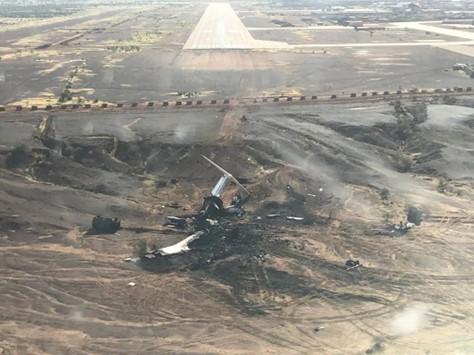
Given the developments and incidents outlined above, it is clear that overall the trend of an ever increasing intencity of terrorist operations in the region is continuing, despite the fact that the propaganda outlets of the terrorist groups are not claiming more attacks this month when compared to August. It will be important to see whether or not ISGS continues its strategic silence beyond September. Undeniably, the group continues to play a central role in the deteriorating security situation in Mali and Niger.
Table 1 : Claimed Attacks (December 2022- September 2023)
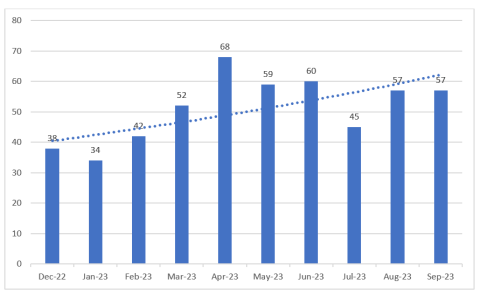
Table 2 : Claimed Attacks per Group (December 2022 - September 2023)
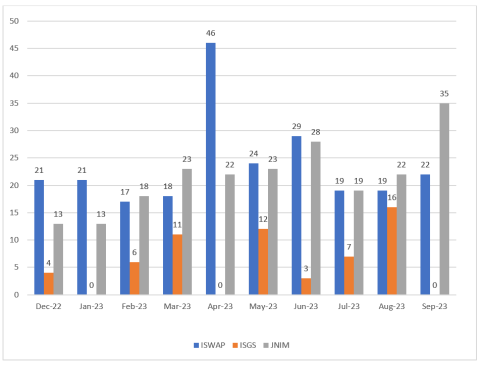
Table 3 : Claimed Attacks per Country (December 2022 – September 2023)
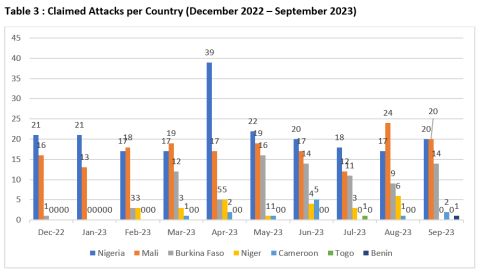
Attacks per Country
Even though ISGS remained silent and has conducted, unclaimed, attacks in Niger in the last month, the only attacks the propaganda outlets of the other terrorist groups claimed were conducted in Nigeria (20), Mali (20), Burkina Faso (14), Cameroon (2) and Benin (1). The attack in Benin was the first time that any of the terrorist networks operating in the region claimed an operation in that country. Currently, this was clearly only a spill-over of terrorist violence into Benin. However, given the overall intensity of terrorist violence in Burkina Faso and the increase in terrorist violence in Niger, Benin is at risk of more terrorist intrusions into its territory. This is a significant development as Benin is one of the coastal states on the Gulf of Guinea and remained unaffected by terrorist violence until now.
Map 1: Frequency and spatial distribution of al-Qaeda and Islamic State affiliates (January 2013 – July 2023)
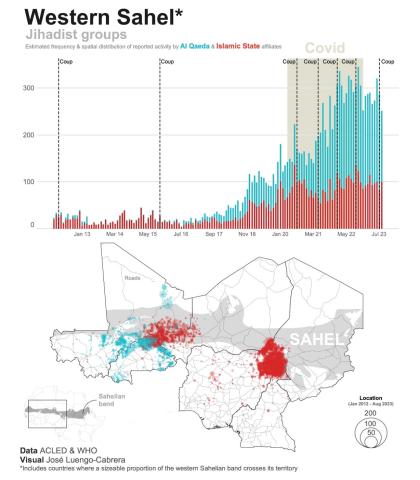
Source: https://twitter.com/J_LuengoCabrera/status/1707313287921107049/photo/1
Map 2: Frequency and spatial distribution of incidents by type of violence
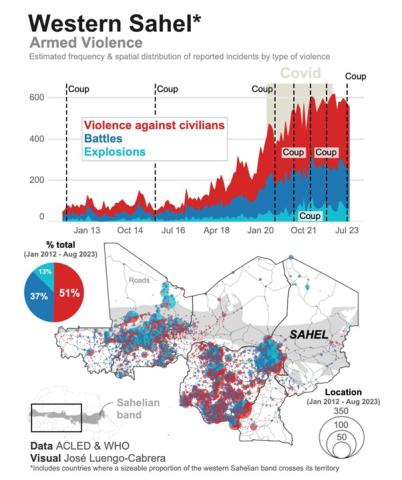
Source: https://x.com/J_LuengoCabrera/status/1707777866484625901?s=a fu20
- Mali
The situation in Mali has reached a critical state. The agreement between ISGS and JNIM means that both terrorist groups will no longer divert resources to their competition but are dividing the country into separate areas of operation. Given that both ISGS and JNIM were able to significantly increase their operational areas in the country over recent months, a complete destabilization of the country is now a distinct possibility.
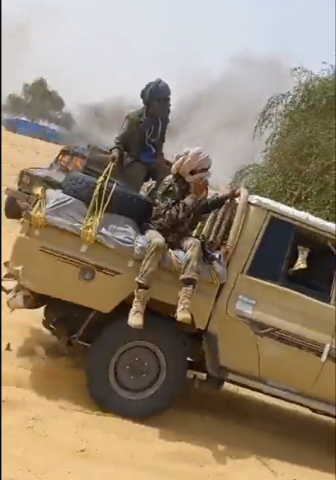
Source: (Video still JNIM Bamba) https://x.com/SimNasr/status/1701977739887059227?s=20
On September 14, 2023, another Wagner helicopter was taken down by JNIM.
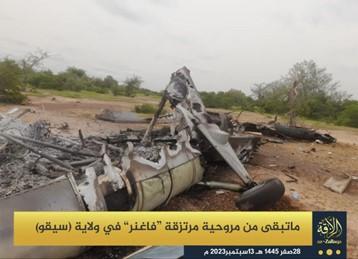
On September 17 Mali, Niger and Burkina Faso established the so-called Sahel security alliance: “Our priority is the fight against terrorism in the three countries,” they stated, ”any attack on the sovereignty and territorial integrity of one or more contracted parties will be considered an aggression against the other parties.”
- Nigeria
Twenty attacks were claimed in Nigeria and were of relatively small impact. The reporting by terrorist propaganda outlets concerning casualty numbers of these attacks was relatively vague but it became clear that only a relatively small number of casualties occurred per attack. One consistent trend since the monitoring started at the end of 2022 is the lower level but very persistent attack strategy of ISWAP in Nigeria. The violence by ISWAP in its attacks is relatively small in scale, but attacks occur regularly, creating a constant sense of insecurity in the operational area of ISWAP.
- Burkina Faso
In 14 different attacks, around 100 Burkinabe soldiers and militia members were killed by JNIM. The most impactful attack was on September 4 when JNIM overrun an army base, killed over 50 Burkinabe soldiers, and captured a signficiant number of weapons and ammunition.
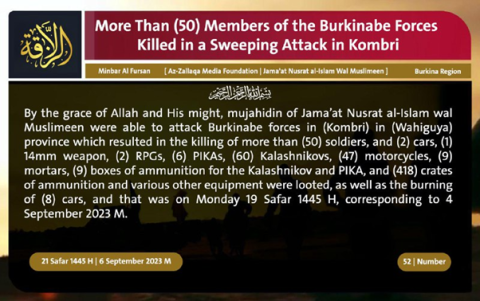
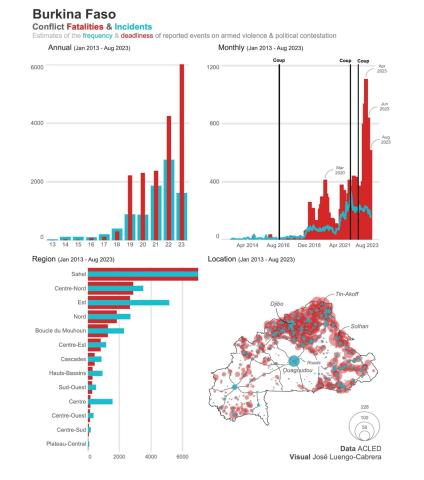
- Niger
Not a single attack was claimed in Niger by any of the propaganda outlets linked to the terrorist networks operating in the region. However, other credible sources reported that ISGS did attack the Nigerien army during September.
“Niger: 55 soldiers killed in two days.
“Elements of the Nigerien Armed Forces fell into an ambush by the Islamic State in the Great Sahara (EIGS) in Imbalagan 4 km north of Ezza (border with Mali). A first unofficial assessment reports 33 dead, 12 injured, 6 vehicles destroyed and 5 taken away. Last Thursday, September 28, in the Tillabéri region (west), ‘a unit of Operation Almahaou on a security mission in Kandadji, was violently attacked by several hundred terrorists’, according to Minister and General Salifou Mody, appointed by the military regime resulting from a coup d'état. If the first assessment reported 7 soldiers killed, it has increased in recent hours, now to 22. These two attacks mentioned above now bring to 55, the number of soldiers of the Nigerien armed forces killed in 48 hours. According to Nigerien sources, 3 terrorists were neutralised including Goumbi, Abu Harouna.”
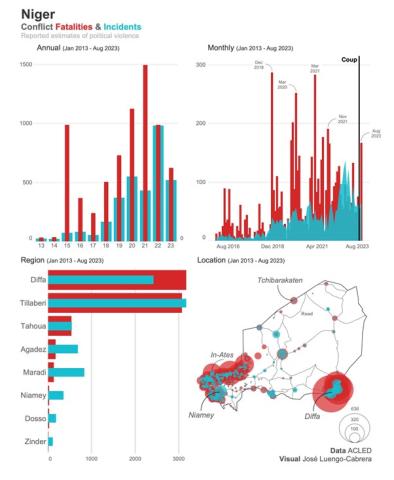
- Cameroon
Two incidents were claimed on the border of Nigeria and Cameroon. In total, 30 Cameroonian soldiers were killed by ISWAP.
- Togo
No incidents were claimed in Togo.
- Benin
In one single attack on the border with Benin JNIM killed 3 Benin soldiers.
Table 4: Total Number of Attacks
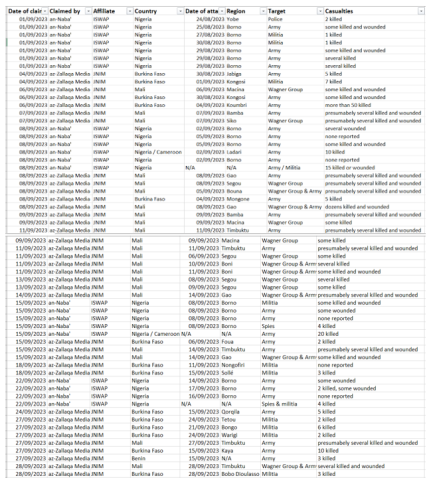
Attacks per affiliate
JNIM
During September a total of 35 attacks were claimed by JNIM. On multiple occasions the Malian army and the Wagner Group were targeted. The most impactful attacks in the entire Sahel in September were conducted by JNIM.
Table 5: Attacks by JNIM
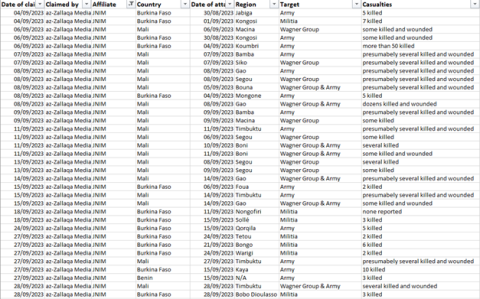
ISGS
As outlined above, not a single attack was claimed by ISGS.
ISWAP
A total of 22 incidents were claimed by ISWAP. The attacks on the border between Nigeria and Cameroon were of relatively high-impact, resulting in the killing of 30 Cameroonian soldiers.
Table 6: Attacks by ISWAP
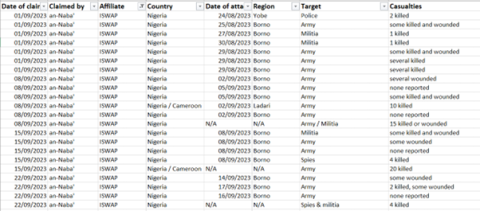
Conclusion
Since the last few months, the evolution of the Jihadi terrorist violence in the Sahel has continuously increased and is approaching critical levels. This situation is caused by several worrying occurences and trends. First, the ceasefire agreement between ISGS and JNIM frees up resources of both terrorist networks which are now devoted against Malian security forces and Wagner troops. Both terrorist groups are dividing Mali into distinct operational zones, which is likely going to increase the operational impact of both groups. The first terrorist attack in Benin is a stark reminder of the strategic risks that will develop if terrorist networks are able to reach the Gulf of Guinea. The military coup in Niger and the withdrawal of French and other Western forces from the country and the suspension of EU security cooperation means that a key regional security hub, stemming terrorist violence is no longer operational. This developing security vaccum is continuously filled by the Wagner Group, which is increasing its footprint in the region. The tri-partite security pact between the coup regimes in Mali, Burkina Faso, and Niger is not primarily geared towards increased cooperation against terrorist violence but clearly meant as a deterrence against other regional countries aiming to restore civilian and democratic rule in these three countries. The combination of these various factors means that the regional security outlook is further deteriorating.

The Counter Extremism Project Presents
Enduring Music: Compositions from the Holocaust
Marking International Holocaust Remembrance Day, the Counter Extremism Project's ARCHER at House 88 presents a landmark concert of music composed in ghettos and death camps, performed in defiance of resurgent antisemitism. Curated with world renowned composer, conductor, and musicologist Francesco Lotoro, the program restores classical, folk, and popular works, many written on scraps of paper or recalled from memory, to public consciousness. Featuring world and U.S. premieres from Lotoro's archive, this concert honors a repertoire that endured against unimaginable evil.